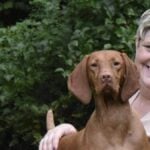
Home » Insights from Sporting Group Judge Cindy Lane

Interview with Sporting Group Judge Cindy Lane.
1. Where do you live? How many years in dogs? How many years as a judge?
2. What is your original breed? What is/was your kennel name?
3. Can you list a few of the notable dogs you’ve bred? Any performance or field titles?
4. How important are Performance and Companion titles in a Sporting Dog?
5. Have you judged any Sporting Breed Specialties?
6. Do you find that size, proportion, and substance are correct in most Sporting breeds?
7. Is breed-specific expression important to you as a judge? Can you offer some examples?
8. What are your thoughts on the current grooming practices among the coated breeds?
9. Are the Sporting breeds in good shape overall? Any concerns?
10. In your opinion, how do today’s exhibits compare with the Sporting Dogs of the past?
11. Why do you think the Sporting breeds make up a large portion of the typical show’s entries?
12. Just for laughs, do you have a funny story you can share about judging the Sporting Group?
Sporting Group Judge Cindy Lane
I have been breeding and showing Cocker Spaniels since 1975. Several (of about 60 AKC champions) are listed as American Spaniel Club’s Hall of Distinction ROM and LOM Top Producer Award recipients. Among these, there have been National Specialty WD, WB, BOV, Futurity and AOM winners, and BISS winners.
I began judging in 2007 (AKC #65098). I presently hold regular status approval for the Sporting, Non-Sporting, and Toy Groups, Best in Show, as well as Great Danes and many Terrier breeds. I am a retired NBPTS mathematics teacher.
I am a Lifetime Member of the American Spaniel Club, Inc. and the Carolina CSC, Inc. I serve as a parent club approved mentor for Cocker Spaniels and I’m a member of the Dog Judges Association of America and the American Dog Show Judges organization.
Where do I live? How many years in dogs? How many years as a judge? I live in Clarkesville, Georgia. I’ve been in dogs for about 45 years. I began breeding Cockers in mid-1970s and then exhibiting in the late ‘70s. I’ve been judging for about 14 years.
What is my original breed? What was my kennel name? My first breed is the Cocker Spaniel. My kennel name is Cin-Dee’s.
Can I list a few of the notable dogs I’ve bred? I was lucky enough to have bred top-producing sires and dams in Black Cockers as well several placing in Top 10 statistics. These are listed among the American Spaniel Club’s Producers Hall of Fame: CH Cin-Dee’s Knight Lights LOM, CH Cin-Dee’s Masked Man ROM, CH Cin-Dee’s Mona Lisa, CH Cin-Dee’s Double Dip LOM, CH Cin-Dee’s Double Dots ROM, CH Cin-Dee’s Triple Crown ROM, CH Cin-Dee’s Funny Valentine LOM, CH Cin-Dee’s Princess Leia, CH Cin-Dee’s Genuine Issue ROM, CH Cin-Dee’s Have You Heard ROM, and CH Cin-Dee’s Just Keep Me Moving. Most may remember those who either won the ASC Futurity or Best of Variety in Futurities, beginning in 1989-2000. I was lucky to have bred several ASC National WD/WB/BOV/AOM and Best in Specialty Show winners. I have always credited those who came before me who provided exceptional foundation dogs that I began my breeding program on. I was mentored by some of the greats in Cockers, Laura Henson of the Kaplar fame and Betty Schachner of Plantation Kennels. I was given guidance on how to study pedigrees and on the importance of using proven sires, and how to value a good bitch line. The soundness of body and temperament was always preserved as well as good type. A beautiful dog that could still perform his job of flushing in the field, a calm pet, and a winning show dog was my goal.
How important are Performance and Companion titles in a Sporting Dog? These titles are a very important components to the total Sporting Dog as they tie form to function and verify the trainability of a loyal companion. It is essential that the breed be built to perform its original job and demonstrate temperaments of a willing and dependable worker. In the case of today’s Cockers, the coat may be cut down to work in the field.
Have I judged any Sporting Breed Specialties? I have been honored to judge my own breed’s National (American Spaniel Club) and the Canadian Cocker Spaniel Regional Specialty that followed the Canadian National. I have judged the Maryland Sporting Dog Association’s Group show as well as Rainier SDA and the Southern California Dog Fancier Group show. I was pleased to judge Brittany, Cocker, English Cocker, Springer, English Setter, Irish Setter, German Shorthair, Vizsla, and Weimaraner specialties in various parts of the country.
Do I find that size, proportion, and substance are correct in most Sporting breeds? I often see Golden Retrievers and Labrador Retrievers lacking enough leg of length. I have also seen this trend in Nova Scotia Duck Tolling Retrievers as well as in English Cockers. As far as size, I have noticed Vizslas, Weimaraners, German Shorthairs, and Wirehaired Pointing Griffons are often taller than ideal.
Is breed-specific expression important to me as a judge? Can I offer some examples? Expression is from the eye shape, placement, size, and color of the eyes. The beautiful Irish Setter has a medium to dark brown, somewhat almond-shaped eye (placed rather well apart) with a tight eye rim. I look for the chiseling around and below the eyes. The lovely English Setter has a preferred dark eye that is nearly round and is fairly large with a tight eye rim that is fully pigmented. Both breeds have a soft and intelligent expression. The terrific Gordon Setter has a dark, oval eye with a bright expression, whereas the Irish Red & White has a dark, round eye that is either brown or hazel with a kindly gentle expression. I always walk down the line to focus on expression when comparing heads, since it is important to me.
What are my thoughts on the current grooming practices among the coated breeds? I highly value a clean, and properly and neatly trimmed, breed that follows the natural lines/outline of the body. Proper texture of both undercoat and outercoat is the key; certainly not the quantity of coat.
On the other hand, a sculpted trim is not appealing to me in any Sporting Dog. If the feathering is dead straight with no wave, and the trim line underneath is a straight scissor line, it makes more of a caricature to me. A good quality coat should not require a flat iron to be appealing nor is excessive feathering needed or desired on a Sporting Dog. The purpose of the coat is to be an insulator and protective, whether running through briars or swimming in freezing water. A good coat will shed the mud and water and will not allow the water to get to the skin.
Are the Sporting breeds in good shape overall? Any concerns? I have noticed regional differences in the quality of dogs exhibited at all-breed shows here in the US. I have judged some of the rarer breeds and found examples in better shape than those breeds with larger entries. Possibly, those “rustic” breeds that are presented more naturally have not suffered any ill effects of human over-interference? I have been pleased with some impressive Flat Coats, Wirehaired Pointers, Spinones, and Welsh Springers. I have been pleased with bites and temperaments of most Sporting breeds.
Front assemblies are not where they should be in many Sporting breeds. Various issues affecting the total, correct front construction are often evident. Additionally, long loins, short rib cages, lack of appropriate rib spring, and depth of chest (not reaching the elbow) is a concern. Although the desired amount of bone varies between the breeds, the lack of bone, and therefore good working feet, is disturbing in any Sporting or Working Dog. Temperament is essential in any Sporting Dog. I am concerned with seeing some overly shy breeds, such as I have experienced with some Pointers and Weimaraners, unfortunately.
Temperament is essential in any Sporting Dog.
In my opinion, how do today’s exhibits compare with the Sporting Dogs of the past? Shoulder construction is critical as well as a balanced rear and a nice, short hock. Many though, nowadays, have straighter fronts and over-angulated rears that may look impressive stacked, but totally falter when moving. When I look at old photos of many of the great dogs that came before us, I ask myself, “What happened to the gorgeous front constructions, deep and well-muscled bodies, moderate angles, and pleasing heads that were of a functional size and length to do their jobs as a Sporting Dog?”
Although my own breed has changed immensely from its past greats, I would say that most breeds have not changed as much and would be recognizable as the same breed we see from decades past. I would say, though, in the effort to produce the show dogs that can compete at the Group level, we now often see showy animals that impress with great speed and extremes of neck lengths and over-angulation. As we all know, this is a detriment to the Sporting breeds, where balance is key and the dogs must be well-made to work all day without tiring. I would like the Group dog to be shown at an ideal trot, with the head not held artificially high either by a short, tight lead or by training that makes it look awkward. As speed increases, the head should slightly lower to allow for good reach.
Why do I think the Sporting breeds make up a large portion of the typical show’s entries? Sporting breeds are versatile dogs. They can easily serve as devoted companions, reliable and useful field dogs, impressive performance animals, and beautiful conformation dogs. Most are fairly easy keepers (minus the heavy-coated breeds) and are easy to travel with. There are a variety of sizes and grooming requirements that would fit the various lifestyles of a range of owners and ages.
